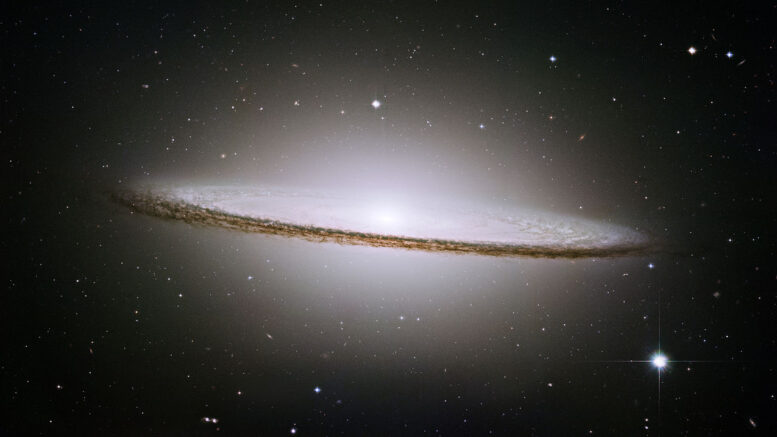Messier 104, also known as the Sombrero Galaxy, is a majestic unbarred spiral galaxy located in the constellation Virgo.
Messier 104 has an incredibly bright nucleus, an unusually large central bulge, and a conspicuous dark dust lane in its disk. The appearance of the galactic bulge and the dust lane that crosses in front of it have earned M104 the name Sombrero. The dust lane has the shape of a symmetrical ring around the bulge. The ring contains most of M104’s cold hydrogen gas and dust and is the primary site of starburst activity within M104.
The Sombrero Galaxy’s large bulge and supermassive black hole at its core make the galaxy a popular target for study. Messier 104 is part of a complex cloud of galaxies located to the south of the Virgo Cluster, but it is unclear whether it belongs to a formal group of galaxies.
| Description | |
| Visible From Pacific Northwest | February to May |
| Best Time To Observe | May |
| Minimum Size Of Viewing Device | Small Telescope |
| Object Type | Spiral Galaxy |
| Designations | Messier 104, M104, NGC 4594, Sombrero Galaxy, PGC 3132, UGC 293, AT20G J123959-113721, 1E 1237.3-1120, 2E 2814, EQ 1237-113, IERS B1237-113, ICRF J123959.4-113722, IRAS 12373-1121, 2MASX J12395949-1137230, MCG-02-32-020, NVSS J123959-113723, 1RXS J123959.8-113725, VCS4 J1239-1137 |
| Right Ascension | 12h 39m 59.4s |
| Declination | -11°37’23” |
| Constellation | Virgo |
| Number Of Stars | 100 billion |
| Apparent magnitude | +8.98 |
| Apparent dimensions | -21.8 |
| Object Radius | 25,000 light years |
| Distance From Earth | 29,300,000 light years |
History
Messier 104 was discovered by Charles Messier’s friend and colleague Pierre Méchain on May 11, 1781. Charles Messier made a handwritten note about M104 and several other objects and added them to his personal list. However, M104 was not officially included in the Messier Catalogue until 1921, when the French astronomer and author Camille Flammarion found Messier’s personal list, identified the object as NGC 4594 or Herschel’s H I.43, and declared that it should be added to the catalogue. Messier added M104 to his personal list on May 11, 1781. He described it as a “very faint nebula, seen by M. Méchain on May 11, 1781.”
Méchain described the discovery in a letter to Johann Bernoulli on May 6, 1783.
On May 11, 1781, I discovered a nebula above the Raven [Corvus] which did not appear to me to contain any single star. It is of a faint light and difficult to find if the micrometer wires are illuminated. I have compared it [its position] on this day and the following with Spica in the Virgin and from this derived its right ascension 187d 9′ 42″ and its southern declination 10d 24′ 49″. It does not appear in the Connoissance des Temps.
Locating M104 In The Sky
Messier 104 is located 11.5 degrees west of Spica, the brightest star in Virgo, and 5.5 degrees east of magnitude 4.31 star Eta Corvi in Corvus constellation. Spica is easy to locate using the stars of the Big Dipper. The line formed by the three stars of the Dipper’s handle extended outward first leads to the bright Arcturus in the constellation Boötes and then to Spica. The Sombrero Galaxy lies just next to the border with Corvus.

Viewing M104
It is visible in binoculars and small telescopes, but only appears as a small patch of light. 4-inch telescopes may hint at the galaxy’s dark dust lane under exceptionally good conditions, but the dust lane usually requires a 10-inch or 12-inch telescope. The galaxy’s bulge and disk are visible in 8-inch and larger telescopes.
Photographing M104
The Sombrero Galaxy is in the constellation Virgo is in prime position for observations and photography during the month of May. Small aperture telescopes will provide a great photo, but telescopes with an aperture over 1000mm will provide a tighter spot. Using R/G/B filters will help bring help out the color. It is recommended to take several hours of exposure to allow for the proper capture of visible data to allow for photographers to have enough data to process. This could mean about 3 to 6 hours worth of exposures, and other settings varying by telescope and setup.
Sources And Further Reading
Descriptions of all of Messier Objects can be found here.
https://www.messier.seds.org/m/m104.html
https://www.nasa.gov/feature/goddard/2017/messier-104-the-sombrero-galaxy
https://www.galactic-hunter.com/post/m104-the-sombrero-galaxy

Be the first to comment on "Messier 104 Sombrero Galaxy"